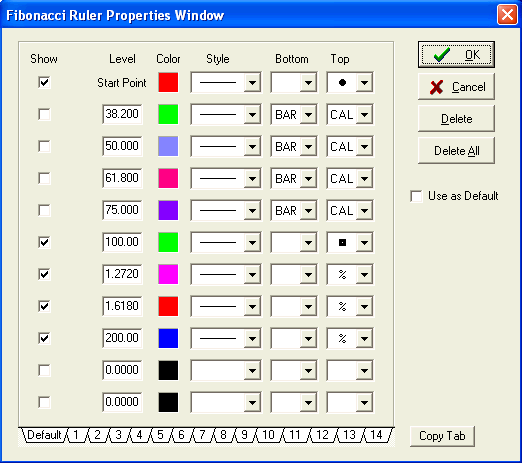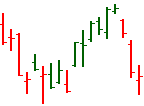January 2000Trading Tip:
Fibonacci Time
Projections
by Howard
Arrington
The Fibonacci sequence involves the use of ratios, and the two
ratios that are focused on in this trading tip are 1.618 and
2.618. Time can be forecast by measuring the horizontal time
period between two points A and B, and multiplying by the Fibonacci
ratios. The result is plotted rightward from point A.
Fibonacci time projections can be made from top to top, bottom to
bottom, or top to bottom. Because of the multiplicity of swing
tops and bottoms, there is the problem of a multitude of possible
relationships. One solution to the problem is to use this tool
in conjunction with other time-oriented information, such as Elliott
wave counts or cycle analysis.
The following chart illustrates three Fibonacci Time
Projections. Each time period measured is marked with blue
lines and arrows labeled A and B. The forecasts are marked
with red lines and labeled for the Fibonacci ratio used.

Fibonacci Time Projects are easy to make using the
Fibonacci Ruler tool in Ensign Windows. The
percentages, colors and markers are configured on the tool's
property form.

Study Insight:
Trends Color Bar
Study
by Howard Arrington
 The Trends study is applied to a chart by clicking on
the Color Bars button, and selecting Trends in the list. Bars
in an Up trend are colored with one color, such as green, and bars
in a Down trend use a different color, such as red. This is
the logic used to create the Trends Color Bar study. The Trends study is applied to a chart by clicking on
the Color Bars button, and selecting Trends in the list. Bars
in an Up trend are colored with one color, such as green, and bars
in a Down trend use a different color, such as red. This is
the logic used to create the Trends Color Bar study.
This code is called in a loop so the test is made for each bar on
the chart. The rPaint array will store a value of 1 to
color the bar for an Up trend, or the value of 2 to color the bar
for a Down trend.
if rPaint[y]=1 then begin
if (r[w].h=r[y].h)
and (r[w].l<r[y].l) then begin rPaint[w]:=2; exit;
end;
if (r[w].h>=r[y].h) or (r[w].l>=r[y].l)
then begin rPaint[w]:=1; exit; end;
end;
if rPaint[y]=2
then begin
if (r[w].l=r[y].l) and (r[w].h>r[y].h) then
begin rPaint[w]:=1; exit; end;
if (r[w].l<=r[y].l) or
(r[w].h<=r[y].h) then begin rPaint[w]:=2; exit;
end;
end;
if r[w].h>r[y].h then rPaint[w]:=1
else if
r[w].l<r[y].l then rPaint[w]:=2
else
rPaint[w]:=rPaint[y];
r[] is an array of bar records. The .h field is the bar's
high. The .l field is the bar's low.
The index w
references the bar being tested, and y is the index for the
adjacent bar to the left.
The programming logic can be expressed with this word
description:
If the previous bar's trend is Up, then make two
tests:
If the current high is equal to the previous
high and the current low is below the previous low, then color this
bar Down.
If the current high is at or above the previous
high or the current low is at or above the previous low, then color
this bar Up.
If the previous bar's trend is Down, then make two
tests:
If the current low is equal to the previous
low and the current high is above the previous high, then
color this bar Up.
If the current low is at or below the
previous low or the current high is at or below the previous high,
then color this bar Down.
If the current bar has not be colored by the above tests, then
make these tests:
If the current high is above the
previous high, then color the bar Up.
If the current low
is below the previous low, then color the bar
Down.
If the bar's trend is still undetermined, let
it be a continuation of the same trend as the previous bar.
Article:
January Effect
by
the ChartDr, 12-26-1999
http://www.chartdr.com/
"With the beginning of a new year, century and millennium,
investors would do well to reflect on a seasonal pattern to stock
movement generally described as the "January Effect". The January
Effect describes the physical result of the termination of year end
tax loss selling. Looking at seasonal fourth quarter price activity
in issues which under performed broad market results during the
first three quarters, year in and year out there has been a tendency
for lagging issues to perform even worse during the last three
months. Tax selling by many institutions in October (timing
determined largely by fiscal year end) through December, when public
investors tend to offset gains with losses, often serves as a
physical weight, depressing share prices below levels justified by
companies' fundamental outlooks."
"The natural consequence of this year end selling activity has
been described as the oft-anticipated year end or Christmas rally
because this concentrated selling activity seems to peak around
mid-month. For this reason, every year I like to search for unusual
values around this time. A good screening tool at this time is the
list of issues making new lows, as such issues may offer extreme
values, at least good for a few weeks of resulting gains as tax
selling dissipates."
"In fact, such resulting strength may have already begun for a
number of well-known issues. The shares of Eastman Kodak, one of the
Dow Jones 30 Industrials, rose overnight to 63 3/4 on 12/22 from
it's 56 5/8 annual low of 12/21. Since 12/14, the shares of another
blue chip issue, Boeing, have risen nearly 10% from a seven month
low,37 5/16, to 40 1/4. After declining from 57 1/4 November 18 to
40 1/4 December 20, a three day advance has already carried the
shares of Schering Plough to 44 15/16, for a quick 10% gain. Even
the interest-sensitive electric utility industry, weighted all year
by rising interest rates may be starting to share in this
phenomenon. The shares of electric utility Unicom Corp. have risen
from 31 5/16, a small fraction above it's 52 weekly low, to 34 3/16
in four days since December 20, again, nearly 10%. Since creating a
new 52 weekly low 12/17 at 8 3/8, the shares of Hilton Hotels have
risen as high as 9 3/8, for a gain of 12%... so far."
"As we approach Y2K, after reflecting on amazing results of the
past 12 months, it appears that the potential for extraordinary
gains from the January Effect is enhanced this year as a natural
consequence of the tremendous gains experienced this year. Bon
appetite!"
(Published by permission of Paul Stockinger. All views
expressed in this article are those of the author.)
Profile:
Dr. John Arrington
ES: What is your experience in trading?
JA: I am a civil engineer, but I have been trading the
futures markets for 25+years. I trade Live Cattle and Live Hogs on
the CME with an occasional trade in Bellies and grains.
ES: What do you look for in the markets, and what studies
do you use?
JA: I watch for divergence between prices and the Relative
Strength Index indicators for long-term trades. Time frame for
the RSI indicator is not important so I use the same 14-bar Close
RSI parameter on all charts. For day-trades I watch tick
charts and 5-minute charts, and just follow my feeling for the
market. I read all the news stories with fundamental
statistics, and follow the Cattle On Feed reports and the Daily Meat
price reports. So I have an expectation of where the cattle and hog
markets should go for the next week. My short term trades are
daily or 1-2 weeks. My long term trades are held for several months.
ES: I remember in November 1998 you published your cattle
research results to the Ensign Discussion Group. What kind of
research do you do?
JA: That was some interesting cycle research that indicated
a high probability of a contract low around the first week of
December, followed by a contract high in the middle of March.
The analysis used the last 20 years of data for the April
Live Cattle contract. I do my own research using the ESPL
programming language in Ensign Windows, or write my research
programs in Delphi.
ES: What research projects might you be working on
now?
JA: Currently I am interested in Neural Nets. I am
testing short term networks that use daily ticks to predict
tomorrow's action. I am also testing longer term networks that
use daily bars to predict the next 10 days. I use the QNetV2K
Neural Net software and have implemented their dynamic link library
into my custom programs written in Delphi. I recently finished
automating the data handling process. Using the ESPL
programming language in Ensign Windows and external DLLs, I groom
today's data sets, pass data structures to QNet, and plot the QNet
forecast as an overlay on the host cattle chart. The entire
process is scheduled in Ensign Windows and runs unattended after the
markets close.
ES: What pit falls do you counsel new traders to avoid
as they search for the Holy Grail of trading?
JA: Don't OVERTRADE. There are times when all your
trades will be against you. Be ready to take your losses and
live to trade another day. Your First Loss is your Least
Loss. If you cannot sleep at night then reduce your positions
to where you can sleep at night.
ES: Does the Holy Grail exist?
JA: No, there is no Holy Grail. There is only lots of
work and lots of luck. Being prepared contributes to the luck
that sometimes comes along. Remember to take a cookie when
they pass the cookie plate around once in awhile.
ES: You have an impressive trading desk set-up.
Can you elaborate on the computer equipment you use and what this
set-up cost?
JA: I have three 19-inch Viewmate monitors I bought last
summer for $270 each. The main screen on the left shows both
quotes, charts, and news. The other two screens show 8
charts each. My layout has tick, 5-minute, and daily charts
for two cattle contracts, and two hog contracts. I rarely
change charts during the day. My system uses a 300 MHz Hewlett
Packard 6330 computer which cost $550 a year ago. The computer
I research Neural Nets with is a 500 MHz Compaq 5600 computer which
cost $975 last August. Both computers run Windows 98 and
Internet Explorer 5.0. Everything is very stable, and truly a
dream system compared to what I started with 25 years ago. I
have used Ensign Software products since 1982.
 |